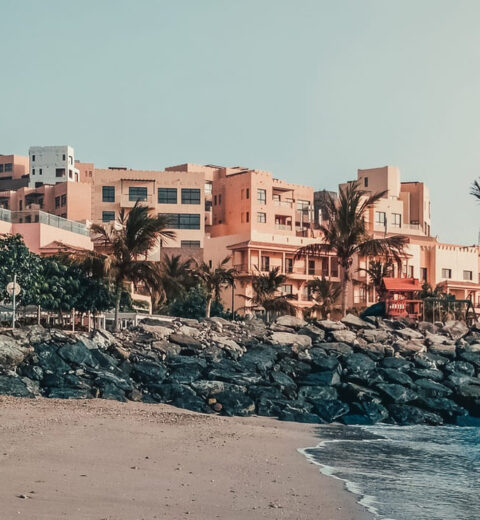Dibba
Dibba is a coastal area in the northern part of the eastern Arabian Peninsula in the Gulf of Oman. It is politically divided into three parts:
• Dibba Al-Fujairah, headed by Emirate of Fujairah, UAE
• Dibba Al-Hisn, head of the Emirate of Sharjah, UAE
• Dibba Al-Baya, run by the government of Musandam, Oman
Dibba Al-Fujairah
Dibba Al-Fujairah is a town located in the Fujairah region, located in the northeastern part of the United Arab Emirates. Part of the Dibba region. Dibba Al-Fujairah is considered to be the second-largest city in Fujairah after Fujairah City. With an area of 68 square kilometers, Dibba Al-Fujairah had an estimated population of 41,017 (average) in July 2019.
History
Dibba Al-Fujairah has many pastures and small areas, including Akamiya, Al-Rashidiya, Wasit, Al-Ghurfah, Sumbraid, Rul Dadna, Al-‘Aqqah, Suwayfah, and Sharm. Akamiya has a health facility, capable of serving 2,000 patients, which opened in 2011 following delays due to staff shortages. This large natural harbor on the east coast of the Emirates to the north has been an important trading post by the sea since ancient times. There is little evidence, especially from the tombs, of the settlement between the late second millennium and the early first century BCE, which existed at the same time as places like Shimal, Till Abraq and Rumeilah. There is also widespread activity during the time of al-Dur and Mileiha but it is in the period before and after the advent of Islam that people heard a lot about Dibba. Under the Sasani, along with their Omani clients, Al-Julanda, there was an important market in Dibba and that was once the capital of Oman. In addition, as the province of Tuwwam, it was taxed by Al-Julanda, who reported to the Persian marzban (governor of the army), who was based in Al-Rustaq in what is now Oman. According to Ibn Habib, “traders from Sindh, India, China, people from the East and the West came to it.
The Battle of Dibba
Shortly after the death of the Muslim Prophet Muhammad, a rebellion broke out in Dibba and the Azd faction, led by Laqit bin Malik Dhu at-Taj, renounced Islam. According to one tradition Laqit was assassinated by King Abu Bakr’s envoy in what would have been a minor struggle, and other sources, including Al-Tabari, say that at least 10,000 rebels were killed in one of Ridda’s major battles, the Battle of Dibba. The plains behind Dibba still have large tombs according to local custom representing the fallen rebels of Dibba.
During the reign of Abbasid ruler Al-Mu’tadid (CE 870-892), a major battle was fought in Dibba during the conquest of Oman by the Abbasid ruler of Iraq and Bahrain, Muhammad ibn Nur. After that reference to Dibba in the history books is scarce until we come to the Portuguese who built the fort there. Dibba (Debe) comes from a list of words written in southeastern Arabia preserved by the Venetian plaque Gasparo Balbi in CE 1580 and drawings of its Portuguese fortress can be found in many sources, such as Armando Cortesão’s Portugaliae Monumenta Cartographica
Geology
The Dibba Fault is a functional error, meaning it has had the most recent migration or earthquake activity and is one of two errors that crossed the UAE. The fault falls in Oman from the north and then runs south to the center of the Arabian Peninsula. Gulf News reports that people in Dibba have heard at least 150 earthquakes in 2003 and 2004, indicating that more earthquakes are expected in the area. Dibba also heard the quake in Qeshm in 2005. The Mesozoic and Cenozoic accretionary wedge are reduced on the west side by a proper lateral defect, the Zendan Fault – Oman Line. West of the transition is the Zagros Mountains of southern Iran, the Musandam peninsula and mountains of Oman, and the Arabian and Dibba Fault. The Dibba error separates the ophiolites from the mountains of Oman and the Mesozoic carbonates in the Musandam Peninsula. On March 31, 2009, Gulfnews reported that the UAE National Center for Metrology and Seismology (NCMS) recorded two earthquakes, measuring 2.9 and 3.5 on the Richter scale, which shook the Gulf of Aden and north of Dibba at 6.21 am and 9.35 am. . Earthquakes were heard less frequently in some parts of the northern kingdom.
Marine life
In 2008 an algal explosion hit the sea around Dibba and reached the tropics of ‘Aqqah andghg Al-Faqeet, which contains several high-profile resorts. 95% of the corals in the Dibba Marine Protected Zone were destroyed and the number of fish decreased to a minimum. Rita Bento, a marine scientist with the Emirates Diving Association (EDA), said she saw only three fish during an hour-long dive in an area where hundreds had previously been seen.
Notable people
Al Muhallab ibn Abi Suffrah, Azdi Arab and a well-known military commander born in Dibba, whose name appeared on the first dirham coin of the United Arab Emirates shortly after the country’s people embraced Islam. Laqit bin Malik: A false prophet and Azdi Arab in Dibba also known as the “One Identified Crown (Dhul’-Taj)” who rebelled against the local Islamic rulers of Jolanda. An army led by Hudayfa and assisted by Ikrimah ibn Abi-Jahl and ‘Arfaja arrived in the Tuwwam area (which includes modern Al Ain and Al-Buraimi areas), where they wrote letters to the local tribes to reassure them of their rebellion. . They then marched and defeated Laqit at the battle of Dibba, where 10,000 casualties were reported. Hudayfah then settled in Oman as ruler restoring peace with the local tribes and restoring the Muslim family, while the remaining troops continued to chase the rebels in Mahra and Ash-Shihr in Yemen. , both in South Arabia.




